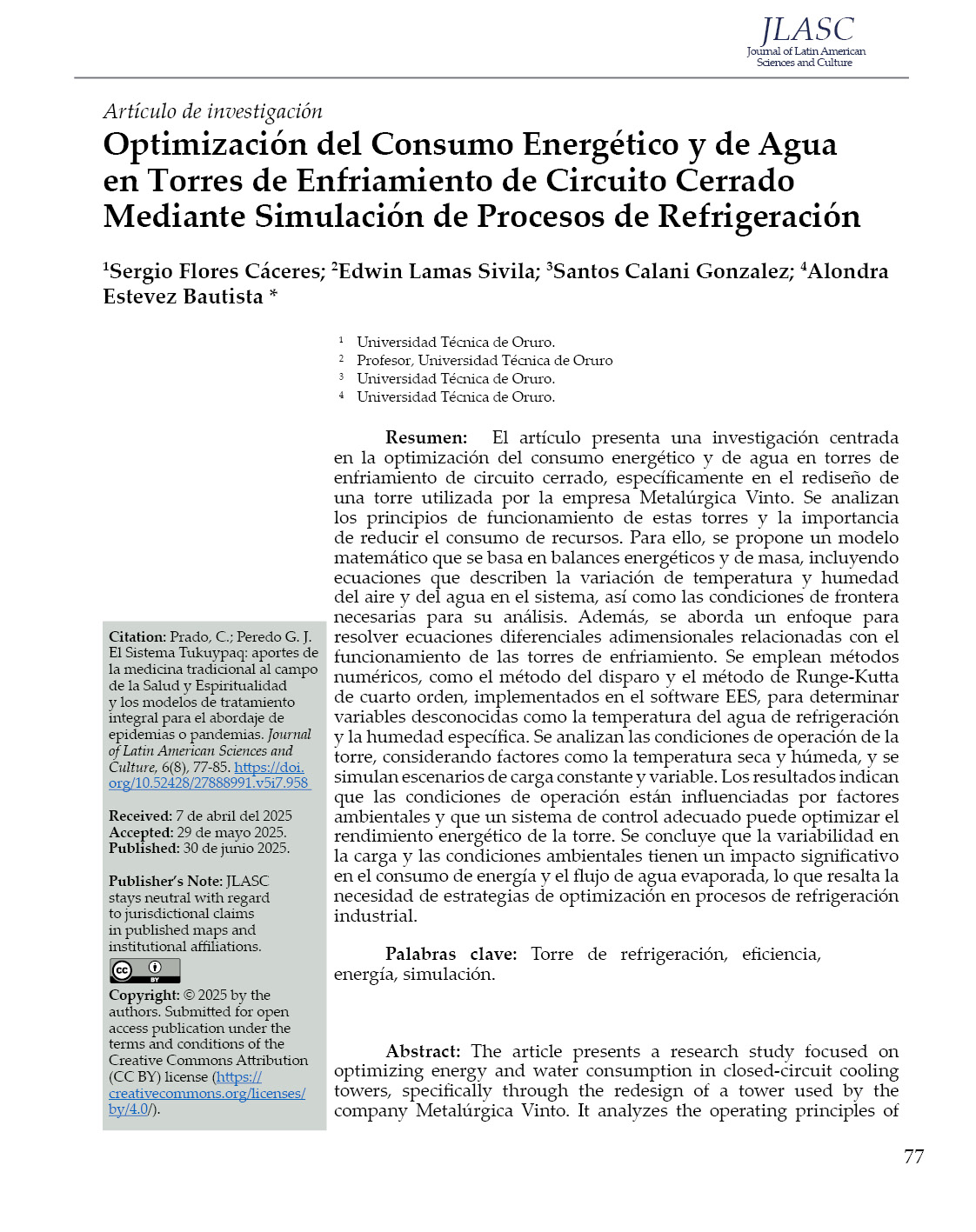Optimización del Consumo Energético y de Agua en Torres de Enfriamiento de Circuito Cerrado Mediante Simulación de Procesos de Refrigeración
DOI:
https://doi.org/10.52428/27888991.v7i10.1274Keywords:
Torre de refrigeración, eficiencia, energía, simulación.Abstract
The article presents research focused on the optimization of energy and water consumption in towers closed circuit cooling, specifically in the redesign of a tower used by the company Vinto Metallurgical. The operating principles of these towers and the importance of reducing resource consumption. For this, a mathematical model is proposed that is based on energy balances and of mass, including equations that describe the variation in temperature and humidity of air and water in the system, as well as the boundary conditions necessary for its analysis. Furthermore, an approach is addressed to solve dimensionless differential equations related to the operation of towers cooling. Numerical methods are used, such as the shot method and the Runge-Kutta method of fourth order, implemented in the EES software, to determine unknown variables such as temperature of cooling water and specific humidity. The operating conditions of the tower are analyzed, considering factors such as dry and humid temperature, and constant load scenarios and variable. The results indicate that operating conditions are influenced by environmental factors. and that an adequate control system can optimize the energy performance of the tower. It is concluded that Variability in load and environmental conditions have a significant impact on fuel consumption. energy and the flow of evaporated water, which highlights the need for optimization strategies in processes industrial refrigeration.Downloads
References
Al-Waked, R., & Behnia, M. (2006). CFD simulation of wet cooling towers. Applied Thermal Engineering, 26(4), 382-395. https://doi.org/10.1016/j.applthermaleng.2005.06.018 DOI: https://doi.org/10.1016/j.applthermaleng.2005.06.018
Lemouari, M., Boumaza, M., & Kaabi, A. (2009). Experimental analysis of heat and mass transfer phenomena in a direct contact evaporative cooling tower. Energy Conversion and Management, 50(6), https://doi.org/10.1016/j.enconman.2009.02.002 DOI: https://doi.org/10.1016/j.enconman.2009.02.002
Milosavljevic, N., & Heikkilä, P. (2001). A comprehensive approach to cooling tower design. Applied Thermal Engineering, 21(9), 899-915. https://doi.org/10.1016/S1359-4311(00)00078-8 DOI: https://doi.org/10.1016/S1359-4311(00)00078-8
Sarker, M. M. A., Kim, E., Moon, C. G., & Yoon, J. I. (2008). Performance characteristics of the hybrid closed circuit cooling tower. Energy and Buildings, 40(8), 1529-1535. enbuild.2008.02.010 https://doi.org/10.1088/1475-7516/2008/02/010 DOI: https://doi.org/10.1016/j.enbuild.2008.02.010

Downloads
Published
How to Cite
Issue
Section
License
Copyright (c) 2025 Edwin Lamas

This work is licensed under a Creative Commons Attribution 4.0 International License.
Authors who publish in this journal accept the following conditions: The authors retain the copyright and assign to the journal the right of the first publication, with the work registered with the Creative Commons 4.0 attribution license, which allows third parties to use what is published as long as they mention the authorship of the work and the first publication in this journal. Authors may make other independent and additional contractual agreements for the non-exclusive distribution of the version of the article published in this journal (eg, include it in an institutional repository or publish it in a book) provided that they clearly indicate that the work it was first published in this magazine. Authors are allowed and encouraged to share their work online (for example: in institutional repositories or personal web pages) before and during the manuscript submission process, as it can lead to productive exchanges, more and more quick citation of published work.








